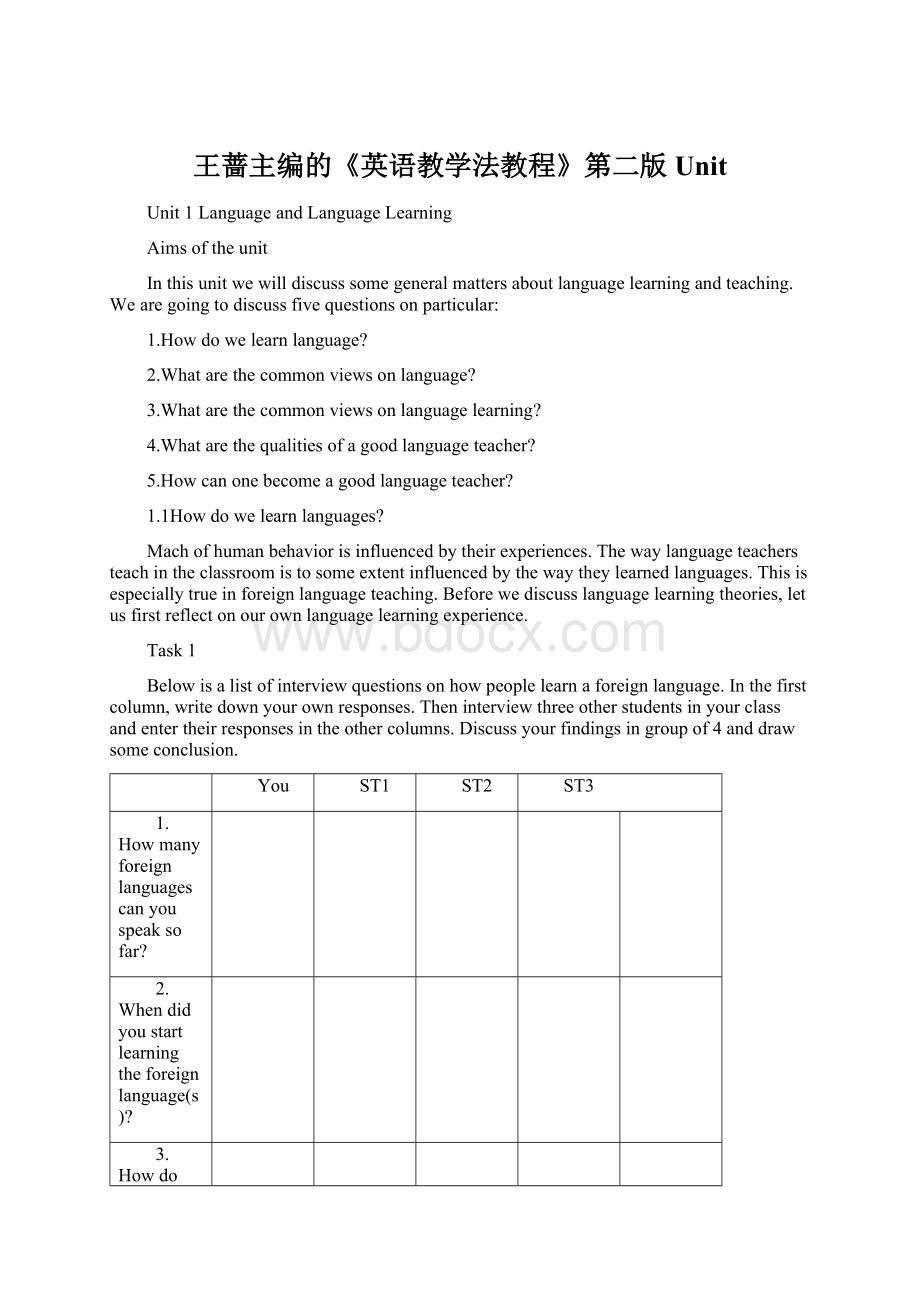王蔷主编的《英语教学法教程》第二版Unit.docx
《王蔷主编的《英语教学法教程》第二版Unit.docx》由会员分享,可在线阅读,更多相关《王蔷主编的《英语教学法教程》第二版Unit.docx(11页珍藏版)》请在冰豆网上搜索。

王蔷主编的《英语教学法教程》第二版Unit
Unit1LanguageandLanguageLearning
Aimsoftheunit
Inthisunitwewilldiscusssomegeneralmattersaboutlanguagelearningandteaching.Wearegoingtodiscussfivequestionsonparticular:
1.Howdowelearnlanguage?
2.Whatarethecommonviewsonlanguage?
3.Whatarethecommonviewsonlanguagelearning?
4.Whatarethequalitiesofagoodlanguageteacher?
5.Howcanonebecomeagoodlanguageteacher?
1.1Howdowelearnlanguages?
Machofhumanbehaviorisinfluencedbytheirexperiences.Thewaylanguageteachersteachintheclassroomistosomeextentinfluencedbythewaytheylearnedlanguages.Thisisespeciallytrueinforeignlanguageteaching.Beforewediscusslanguagelearningtheories,letusfirstreflectonourownlanguagelearningexperience.
Task1
Belowisalistofinterviewquestionsonhowpeoplelearnaforeignlanguage.Inthefirstcolumn,writedownyourownresponses.Theninterviewthreeotherstudentsinyourclassandentertheirresponsesintheothercolumns.Discussyourfindingsingroupof4anddrawsomeconclusion.
You
ST1
ST2
ST3
1.Howmanyforeignlanguagescanyouspeaksofar?
2.Whendidyoustartlearningtheforeignlanguage(s)?
3.Howdoyoufeelaboutlearningaforeignlanguage?
4.Whatdifficultieshaveyouexperiencedinlearning?
5.Whichskilldoyoufindmoredifficulttolearn?
6.Haveyoufocusedonknowledgeorskills?
Why?
7.Whydoyoulearntheforeignlanguage(s)?
8.Doyouconsideryourselfasuccessfullearner?
Why?
9.Whatareyourmostcommonlearningactivities?
10.Doyoulikethewayyoulearnedtheforeignlanguage(s)?
Fromtheabovetask,youmayhavefoundthat1)peoplestartedlearningaforeignlanguageatdifferentages;2)peoplehavedifferentexperiencesinlearningaforeignlanguage,somefinditeasy,somefinditdifficult;3)peoplelearnlanguagesfordifferentreasons;4)peoplelearnlanguagesindifferentways;5)peoplehavedifferentunderstandingsaboutlanguagelearning;6)peoplehavedifferentcapacitiesinlanguagelearning;7)learningcanbeaffectedbythewayitistaught;8)learningisaffectedbythedegreeofsuccessoneisexpectedtoachieve;andmore.Thusthechallengeconfrontinglanguageteachingishowteachingmethodologycanensuresuccessfullearningbyallthelearnerswhohavemoredifferencesthanthecommonality.
1.2viewsonlanguage
Thequestionthatallapproachestolanguageteachingshouldansweris,‘whatislanguage?
’Theanswertothisquestionisthebasisforsyllabusdesigns,teachingmethodology,teachingandassessmentproceduresintheclassroom.Differentviewsonlanguagegeneratedifferentteachingmethodologies.
Task2
Workingroupof4.Brainstormpossibleanswertothequestion:
whatislanguage?
Whenyouareready,joinanothergroupandshareyourideas.
Togiveaconcisedefinitionoflanguagehasalwaysbeendifficultforlinguistsandphilogists.Althoughtherehasbeenanenormousamountofresearchinlanguageinthepastcentury,noauthoritativeanswerhasbeengivento‘whatislanguage?
’rather,peoplehavesettledowntotalkaboutviewsoflanguage,seeminglyallowingfororacceptingdifferenttheoriesforthemoment.However,languageteachersclearlyneedtoknowgenerallywhatsortofentitytheyaredealingwithandhowtheparticularlanguagetheyareteachingfitsintothatentity(Brown,1994a).forsampledefinitionof‘language’,pleaserefertoAppendix1.
Structuralview
Thestructuralviewoflanguageseeslanguageasalinguisticsystemmadeupofvarioussubsystems(Larsen-Freeman&Long,1991):
thesoundsystem(phonology);thediscreteunitsofmeaningproducedbysoundcombinations(morphology),andthesystemofcombiningunitsofmeaningforcommunication(syntax).Eachlanguagehasafinitenumberofsuchstructuralitems.Tolearnalanguagemeanstolearnthesestructuralitemssoastobeabletounderstandandproducelanguage.Whenthisstructuralviewoflanguagewascombinedwiththestimulus-responseprinciplesofbehavioristpsychology,theaudio-lingualapproachtolanguagelearningemerged.
Functionalview
Inthe1960s,Britishlinguistsdevelopedasystemofcategoriesbasedonthecommunicativeneedsofthelearner(JohnsonandMarrow,1981)andproposedasyllabusbasedoncommunicativefunctions.Thefunctionalviewnotonlyseeslanguagesasalinguisticsystembutalsoameansfordoingthings.Mostofourday-to-daylanguageuseinvolvesfunctionalactivities:
offering,suggesting,advising,apologizing,etc.therefore,learnerslearnalanguageinordertobeabletodowithit.Inordertoperformfunctions,learnersneedtoknowhowtocombinethegrammaticalrulesandthevocabularytoexpressnotionsthatperformthefunctions.Examplesofnotionsaretheconceptofpresent,pastandfuturetime,theexpressionsofcertaintyandpossibility,therolesofagents,instrumentswithasentence,andspecialrelationshipsbetweenpeopleandobjects.
Interactionalview
Theinteractionalviewconsiderslanguagetobeacommunicativetool,whosemainuseistobuildupandmaintainsocialrelationsbetweenpeople.Therefore,learnersnotonlyneedtoknowthegrammarandvocabularyofthelanguagebutasimportantlytheyneedtoknowtherulesforusingtheminawholerangeofcommunicativecontexts.
Thesethreeviewspresentaneverwiderviewoflanguage.Thestructuralviewlimitsknowingalanguagetoknowingitsstructuralrulesandvocabulary.Thecommunicativeornotional-functionalviewaddstheneedtoknowhowtousetherulesandvocabularytodowhateveritisonewantstodo.Theinteractionalviewsaysthattoknowhowtodowhatyouwanttodoinvolvesalsoknowingwhetheritisappropriatetodo,andwhere,whenandhowitisappropriatetodoit.Inordertoknowthis,youhavetostudythepatternsandrulesoflanguageabovethesentenceleveltolearnhowlanguageisusedindifferentspeechcontexts.
Theunderstandingofthenatureoflanguagemayprovidethebasisforaparticularteachingmethod(RichardandRodgers,1986),butmoreimportantly,itiscloselyrelatedtotheunderstandingoflanguagelearning.Iflanguageisconsideredtohaveafinitenumberofstructuralitems,learningthelanguageprobablymeanslearningtheseitems.Iflanguageismorethanjustasystemofstructures,itismoreimportantlyatoolthentolearnthelanguagelearning.Iflanguageismorethanjustasystemofstructures,itismoreimportantlyatool,thentolearnthelanguagemeanstouseit,ratherthanjuststudywhatitisandhowitisformed.Thenextsectiondiscussessomecurrenttheoriesaboutlanguagelearning.
ViewsonLanguagelearningandlearningingeneral
Alanguagelearningtheoryunderlyinganapproachormethodusuallyanswerstwoquestions;1)Whatarethepsycholinguisticandcognitiveprocessesinvolvedinlanguagelearning?
2)Whataretheconditionsthatneedtobemetinorderfortheselearningprocessestobeactivated?
Task3
Workingroupsof4.Brainstormtheanswerstothetwoquestionsstatedabove.
Whenyouareready,joinanothergroupandshareyourideas.
Althoughthesetwoquestionshaveneverbeensatisfactorilyanswered,avastamountofresearchhasbeendonefromallaspects.Theresearchcanbebroadlydividedintoprocess-orientedtheoriesandcondition-orientedtheories.Process-orientedtheoriesareconcernedwithhowthemindorganizesnewinformationsuchashabitformation,induction,makinginference,hypothesistestingandgeneralization.Condition-orientedtheoriesemphasizethenatureofthehumanandphysicalcontextinwhichlanguagelearningtakesplace,suchasthenumberofstudents,thekindofinputlearnersreceive,andtheatmosphere.Someresearchersattempttoformulateteachingapproachesdirectlyfromthesetheories.Forexample,theNaturalApproach,TotalPhysicalResponse,andtheSilentWayarebasedononeormoredimensionsofprocessesandconditions.Atthislevel,itistooearlytoformulateaspecificapproach,becausesomeaspectsarestilltoovague,forexample,whatisdoneintheseprocesses.
Behavioristtheory
ThebehavioristtheoryoflanguagelearningwasinitiatedbybehaviouralpsychologistSkinner,whoappliedWatsonandRaynor’stheoryofconditioningtothewayhumanacquirelanguage(Harmer,1983).Basedontheirexperiments,WatsonandRaynorformulatedastimulus-responsetheoryofpsychology.Inthistheoryallcomplexformsofbehavior—motions,habitsandsuch—areseenascomposedofsimplemuscularandglandularelementsthatcanbeobservedandmeasured.Theyclaimedthatemotionalreactionsarelearnedinmuchthesamewayasotherskills.Thekeypointofthetheoryofconditioningisthat‘youcantrainananimaltodoanything(withinreason)ifyoufollowacertainprocedurewhichhasthreemajorstages,stimulus,response,andreinforcement’(Harmer,1983:
30).
Basedonthetheoryofconditioning,Skinnersuggestedthatlanguageisalsoaformofbehavior.Itcanbelearnedthesamewayasananimalistrainedtorespondtostimuli.Thistheoryoflearningisreferredtoasbehaviorism,whichwasadoptedforsometimebythelanguageteachingprofession,particularlyinthe.Oneinfluentialresultistheaudio-lingualmethod,whichinvolvesendless’listenandrepeat’drillingactivities.Theideaofthismethodisthatlanguageislearnedbyconstantrepetitionandthereinforcementoftheteacher.Mistakeswereimmediatelycorrected,andcorrectutteranceswereimmediatelypraised.Thismethodisstillusedinmanypartsoftheworldtoday.
Cognitivetheory
Thetermcognitivismisoftenusedlooselytodescribe